Part of my lazy gardening philosophy revolves around growing as many perennials as I can in my food garden. I mean, if I can maximize output (and enjoyment) while putting in less work, why not?
And that’s what perennials are all about. You plant them once, and you get to enjoy them year after year!
Perennial herbs, in particular, are a favorite in my garden because they’re easy to care for and can fit in small spaces, making it possible to grow them on window sills, in container gardens, or squeezed in between other plants.
There’s also a surprising variety of perennial herbs that are accessible in almost every climate, and many of them are—or will be—staples in your kitchen.
Disclosure: If you shop from my article or make a purchase through one of my links, I may receive commissions on some of the products I recommend.

Annuals vs. perennials vs. tender perennials
In contrast to annuals (which complete their life cycle in just one growing season), perennials live for at least two years. After a full growing season, most perennial plants die back in fall or winter in cold climates, but will re-emerge from their roots in the spring.
There’s another category called tender perennials, which can live for several years in their native habitats but—when grown in cold climates—will die during the first frost because they’re not cold-hardy.
That means a perennial’s life expectancy in your garden will depend on your climate (or microclimate).
If you live somewhere with harsh winters, an herb that’s considered perennial everywhere else may not make it more than a year in your garden. That’s because most herbs are native to warmer climates, such as the Mediterranean or Southeast Asia.
But even if you’re a few zones colder than a perennial herb can take, you can extend its life by covering the plant or mulching its roots in winter, or growing it in a pot and overwintering it indoors.
Best Place to Buy Herb Starts
My absolute favorite place to buy herb starts is Richters. I always find unusual varieties of culinary and medicinal herbs that aren’t sold elsewhere.
What herbs are perennials?
Many herbs in the mint family are perennials, including all types of mint, anise hyssop, oregano, thyme, rosemary, sage, marjoram, lemon balm, and lime balm. These are often called woody herbs because over time as they grow larger, they develop a woody stem.
Then there are the oddballs in the mint family, like basil—which is so sensitive to frost that it’s usually grown as an annual—and summer savory, which is an actual annual (but is closely related to winter savory, a perennial).
It also gets tricky with Roman chamomile (a perennial) vs. German chamomile (an annual), and with members of the daisy family, where Echinacea and tarragon are perennials but their cousins calendula and marigolds are annuals.
No worries about trying to keep all this straight though. I’ve listed my favorite perennial herbs below for you!
Where to Buy Seeds
Growing herbs from seed is the most economical option, and you can often find a wider variety that local nurseries don’t carry.
Perennial herbs you can grow at home
Mint (Mentha sp.)

Mojito, anyone? There are lots of different kinds of mint, from the humble common spearmint (Mentha spicata) to the red-stemmed chocolate mint (Mentha x piperita ‘Chocolate’). One of my personal favorites is the pretty variegated pineapple mint (Mentha suaveolens).
The best thing about mint is that, in most cases, you don’t even really have to try. This herb is highly vigorous; so much so, in fact, that it’s sometimes considered a bit of a weed. It’s generally recommended to contain mint in pots or grow it in its own bed to avoid accidentally setting it free in your garden!
You can grow mint in USDA Zones 3 to 8. The leaves will die off during winter, but come right back once things warm up. You can dry the leaves before the plants go dormant so you can enjoy them year-round.
Anise hyssop (Agastache foeniculum)

As we go through this list, you’ll realize that a lot of the most popular perennial herbs are members of the mint family (Lamiaceae). Anise hyssop is no exception, although it’s not known for its minty flavor. As the name suggests, its scent leans more towards anise or licorice.
Anise hyssop is very decorative, with purple bottlebrush flowers. That’s not all, though: it also makes a great tea and can be used in a range of other recipes. Try it as a seasoning for roast vegetables, in cocktails, or make classic anise hyssop whoopie pies.
You can grow anise hyssop in Zones 4-10. Remember that although this is a perennial, it’s relatively short-lived and will die off after two or three years. Don’t forget to save seeds!
Rosemary (Salvia rosmarinus)

Another one of those great perennial herbs that manages to perfectly combine decorative value and fantastic flavor (and even a bit of aromatherapy) is good old rosemary.
Read more: Science Says the Smell of Rosemary Can Make You Smarter
This shrubby plant is native to the Mediterranean and is easy to recognize by its needle-like leaves and small, purplish or bluish flowers.
It’s perfect for all sorts of recipes: Pair it with grapefruit in my delicious grapefruit-rosemary bread (to accompany a mug of tea) or grapefruit-rosemary jelly, or try it in a refreshing summer rosemary lemonade.
Rosemary is easy to grow if you know what it needs. It loves plenty of sun and needs well-draining soil, as it’s not adapted to growing in a damp medium for extended periods of time. Cultivars with an upright growth pattern can reach up to 5 feet in height, though don’t expect it to be quick. This herb is a pretty slow grower!
Rosemary grows as a perennial in Zones 8 to 10, though you may be able to stretch it to Zone 7 with some winter protection.
I do know of two cultivars that are relatively cold-hardy, however, if you can find them: ‘Barbeque’ rosemary can usually survive Zone 7 if grown in a sheltered spot (out of harsh winds, and perhaps against a building where it can pick up some heat) and ‘Arp’ rosemary has made it through my own Zone 6 garden with a good layer of winter mulch.
Sage (Salvia officinalis)
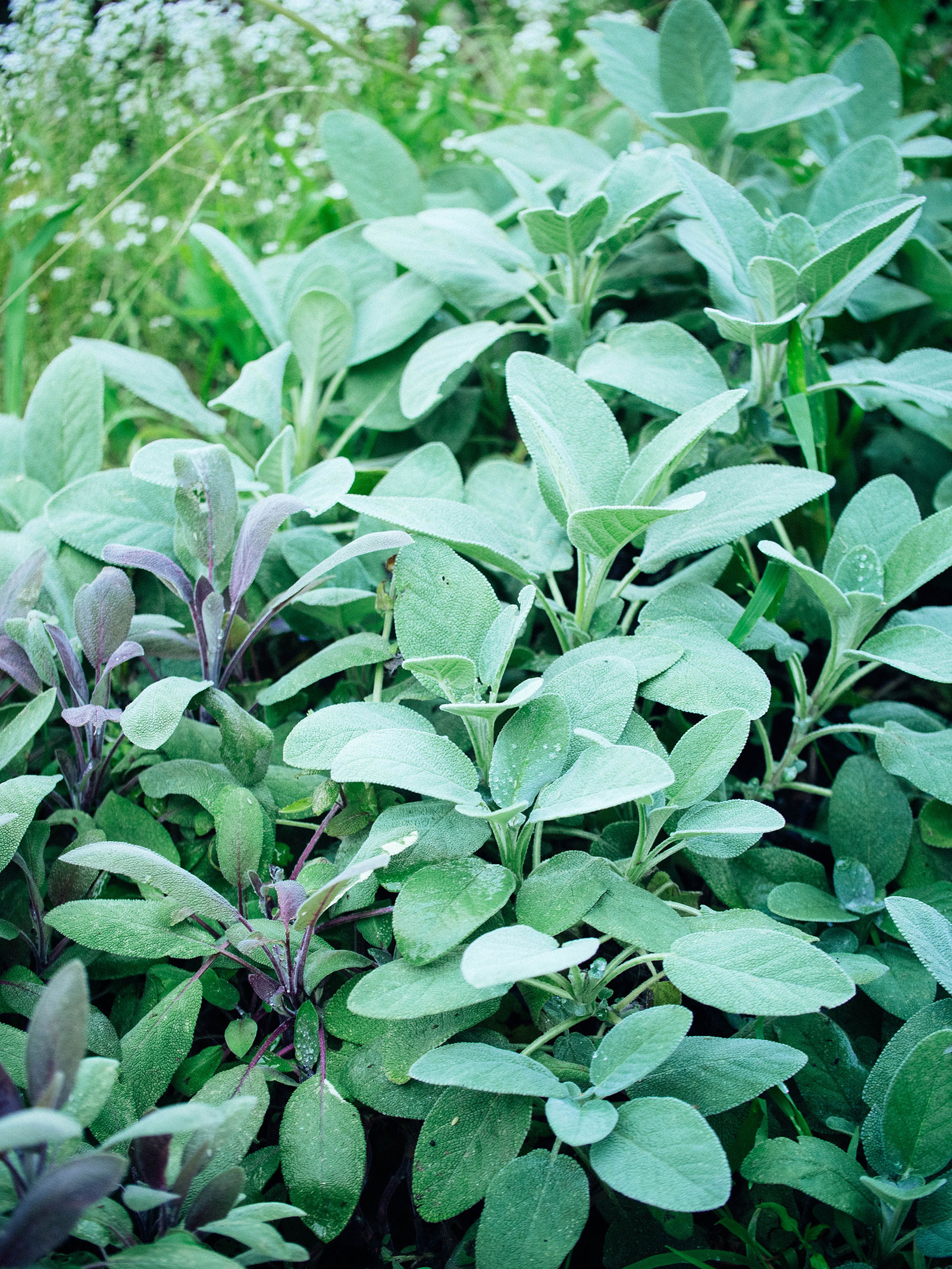
A close cousin of the aforementioned rosemary, sage nonetheless has a distinct appearance and flavor. Like rosemary, it’s a shrubby plant with small purple flowers that originates from the Mediterranean region. However, its pretty silvery leaves are flat. It’s less pungent and more earthy than its cousin.
You can grow sage in USDA Zones 5 to 10. It’s drought-tolerant and easy enough to keep alive as long as you remember to give it plenty of sun. Be sure to also provide a well-draining soil type, as the genus Salvia in general doesn’t tolerate wet feet.
Use sage leaves in all sorts of recipes, from traditional sage brown butter sauce to gnocchi or pasta dishes and, especially, grilled pork. It’s also an essential ingredient in many poultry stuffings.
Oregano (Origanum vulgare)

We all know oregano as the Italian pizza herb, but did you know it’s also amazing in Greek salads and can even be used to make tea? This is an herb that’s easy to grow and a breeze to harvest, and you can even dry oregano in the oven at home for year-round use in all kinds of dishes
Like many of the species on this list, this herb is native to the Mediterranean region, where it grows in a creeping fashion not unlike mint (which it’s related to). This makes it ideal as a useful ground cover for your herb garden!
Related: Beset Edible Ground Covers for Vegetable Gardens
You can grow oregano in Zones 5 to 10; provide plenty of sun and a well-draining soil mixture.
And don’t forget: This is not the only tasty plant in the genus Origanum. (Take its cousin marjoram below, for example.) I’ve also had good experiences with growing za’atar oregano, which is native to the Middle East and used in the popular spice mixture of the same name.
Thyme (Thymus vulgaris)
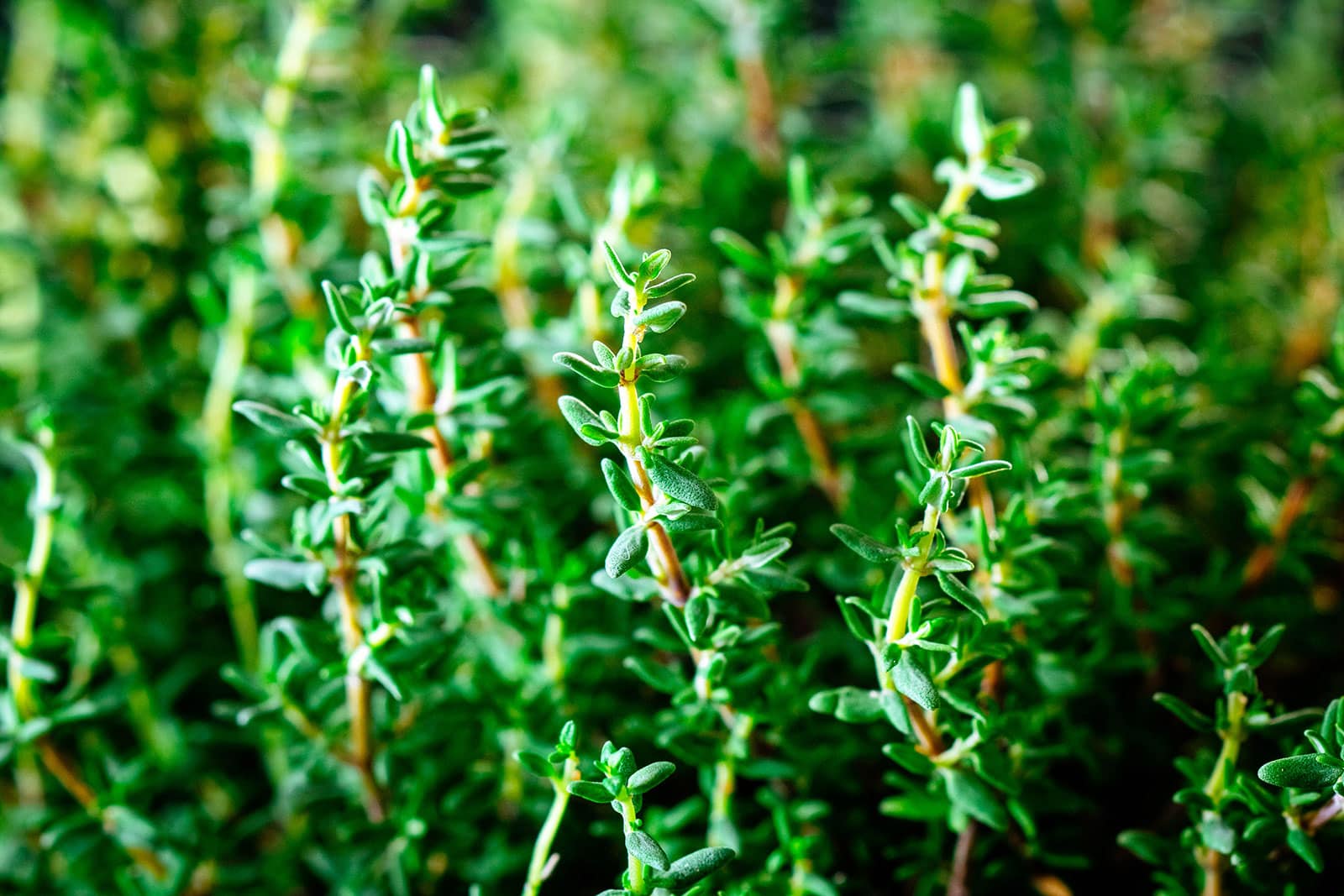
Yet another member of the mint family indigenous to the Mediterranean, I just love the aroma of thyme! This herb has a long history of medicinal and traditional uses, including by the Ancient Egyptians and Greeks. It’s also a popular culinary herb, used to flavor all sorts of savory dishes and even for tea.
There are many useful species in the genus Thymus, but Thymus vulgaris (common thyme) is the most popular. Its creeping growth habit makes it perfect as a ground cover, with the added bonus of pretty purplish flowers and a wonderful fragrance when it’s brushed against.
Some types of thyme are extremely hardy and can survive down to Zone 2. All species can be grown from Zone 5 and up.
Marjoram (Origanum majorana)

As its scientific name gives away, marjoram is closely related to oregano. Crosses between the two actually exist!
The two herbs taste relatively similar, although marjoram is a little sweeter and more subtle than oregano. You can use it for Mediterranean meat dishes, roast veggies and, of course, on pizza.
Marjoram is considered a tender perennial, as it won’t do well outdoors year-round below Zone 9. If you’re in a cooler region and don’t want to grow yours as an annual, you can always grow it in a pot and bring it indoors in winter.
In fact, since marjoram is so vigorous, it may be best to keep it in a planter anyway to keep it from taking over your garden.
Lemon balm (Melissa officinalis)

Native to the Mediterranean and Central Asia, lemon balm is a wonderful herb noted for its sweet lemony scent. It’s long been popular for use in perfumes and for medicinal purposes, but I particularly like using it in the kitchen!
Lemon balm is perfect to add a gentle touch of citrus to salads and fish, and like many of the other herbs on this list, it also makes a great addition to a nice home-blended tisane (herbal tea).
You can grow this herb outdoors in Zones 4 to 9, although it may not be evergreen in cooler regions. It needs a little less sun than many of the other herbs on this list and appreciates damp soil.
Lime balm (Melissa officinalis ssp. altissima)
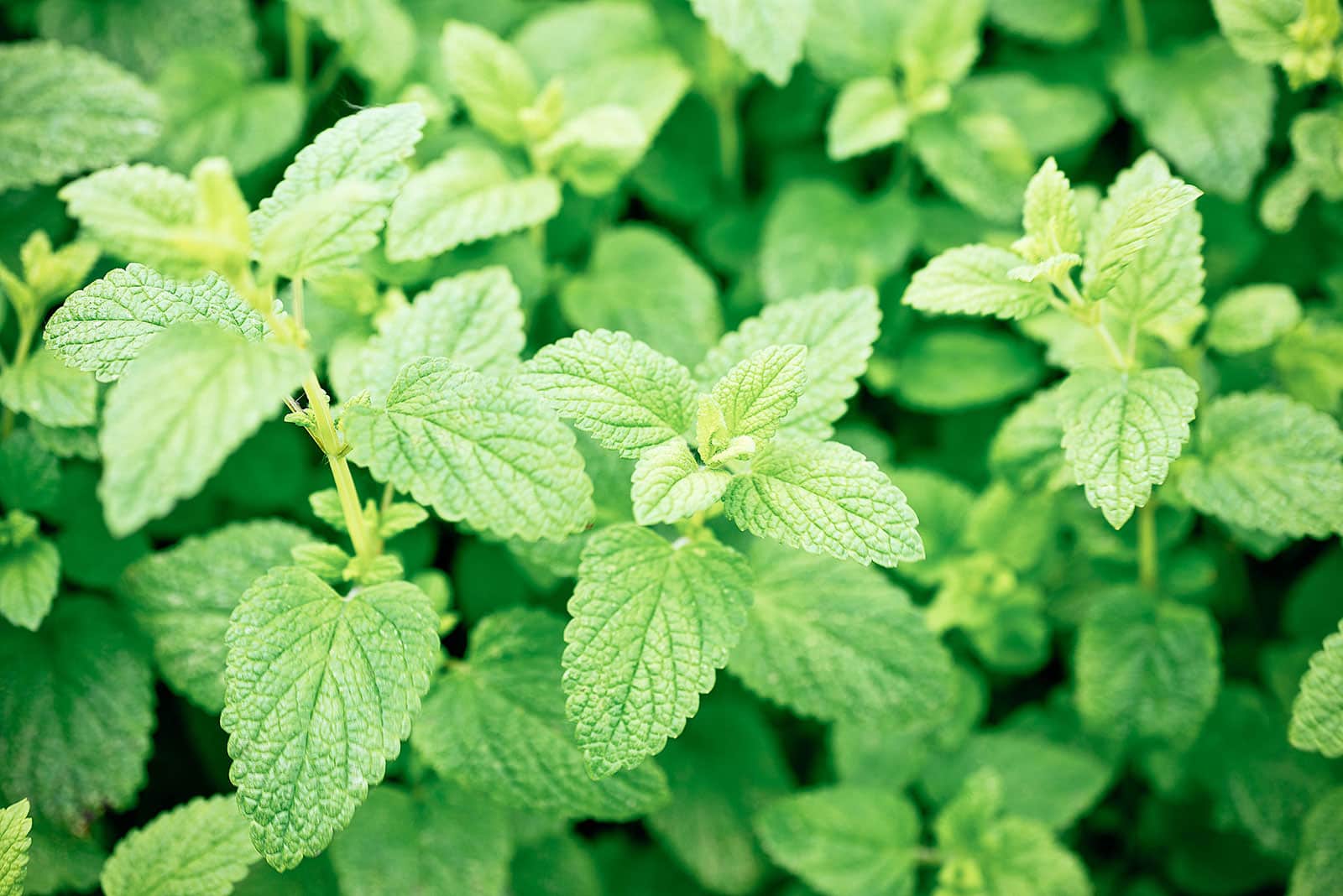
If you like lemon balm, don’t forget to also try lime balm! A subspecies of Melissa officinalis, it’s known for its distinct lime aroma. And like its cousin, it makes a great addition to herbal tea blends, salads, and chicken dishes.
Both lemon and lime balm are pretty vigorous growers, so it’s usually a good idea to contain yours in a planter to prevent it from “escaping.” Lime balm grows as a perennial in Zone 5 and up.
Winter savory (Satureja montana)

Here’s one you may not have heard of before, even though its use is said to date back more than 2,000 years.
Related to the milder but more well-known annual summer savory (Satureja hortensis), winter savory is naturally found in rocky zones in Europe and northern Africa. In the US, it’s hardy down to Zone 6.
It’s quite easy to grow winter savory, as long as you give it well-draining soil and plenty of sun.
It’s used as a companion plant for things like beans, as it’s said to help keep bean weevils under control. Aside from that, it’s also a pretty plant to add to your edible landscape: winter savory produces small white or purplish blooms in summer, which are well-loved by bees and other pollinators.
Read next: Foolproof Five: The Best Flowers to Grow for Bees
When the time comes to prune your plant, you can use the leaves for dishes like beans and poultry. They taste lightly peppery and are sometimes described as a mix of thyme and mint.
Lavender (Lavandula sp.)

Didn’t think I was going to forget about lavender, did you? The shrubby plants of the genus Lavandula offer so many different uses and advantages that it’s impossible to miss them in a list of perennial herbs for your garden.
Originally found in the Mediterranean and as far east as India, lavender is a fantastic multifunctional herb, and it’s easy to grow too. Just give yours full sun (except in really scorching climates, where it’ll appreciate a bit of afternoon shade) and well-draining soil.
There are many different types of lavender with different hardiness ratings, but the most popular, Lavandula angustifolia, will do well down to Zone 5.
Use yours to attract pollinators to your garden, to make delicious floral lavender syrup, steeped in herbal teas, bundled in dried flower arrangements, for homemade potpourris, and much more!
Lemon verbena (Aloysia citrodora)

I’ve already mentioned lemon balm (and lime balm), but did you know there are more distinctly lemony perennial herbs that you can grow in your herb garden?
Lemon verbena, which is naturally found in South America, will also do well in warmer US climates. You can grow it outdoors year-round in Zone 8 or higher.
Like lemon balm, lemon verbena can be used to flavor dishes like fish and poultry. It also goes well in herbal teas, can be used to enrich salad dressings, and makes an excellent addition to a tangy summer cocktail. You can even combine it with lavender, like in my lavender and lemon verbena ice cream!
If you’d like to grow lemon verbena, sun is the most important factor. The soil should be well-draining, but it should also be rich and contain plenty of nutrients for the best results.
Lemongrass (Cymbopogon sp.)

One more lemony herb, shall we? Lemongrass is another one of those multifunctional powerhouses, a perennial herb whose uses range from enriching curry dishes to repelling mosquitos.
Further reading: Growing Citronella, the So-Called Mosquito Plant (Does It Really Repel Mosquitoes?)
Naturally found in Africa and Australasia, it’s unfortunately not very hardy, but you can grow it outdoors year-round in Zones 10 and 11.
I’ve written quite a bit about lemongrass as it’s one of my favorite herbs to grow and eat. If you’d like to plant some, an easy way to get started is by propagating store-bought lemongrass (head to your local Asian grocery store if you can’t find any at the supermarket).
Once your brand-new plants have rooted, learn how to prune lemongrass and how to use it, like in a refreshing sangria with lemongrass, ginger, and peach or a summery lemongrass ginger ale. Yum!
Chives (Allium schoenoprasum)
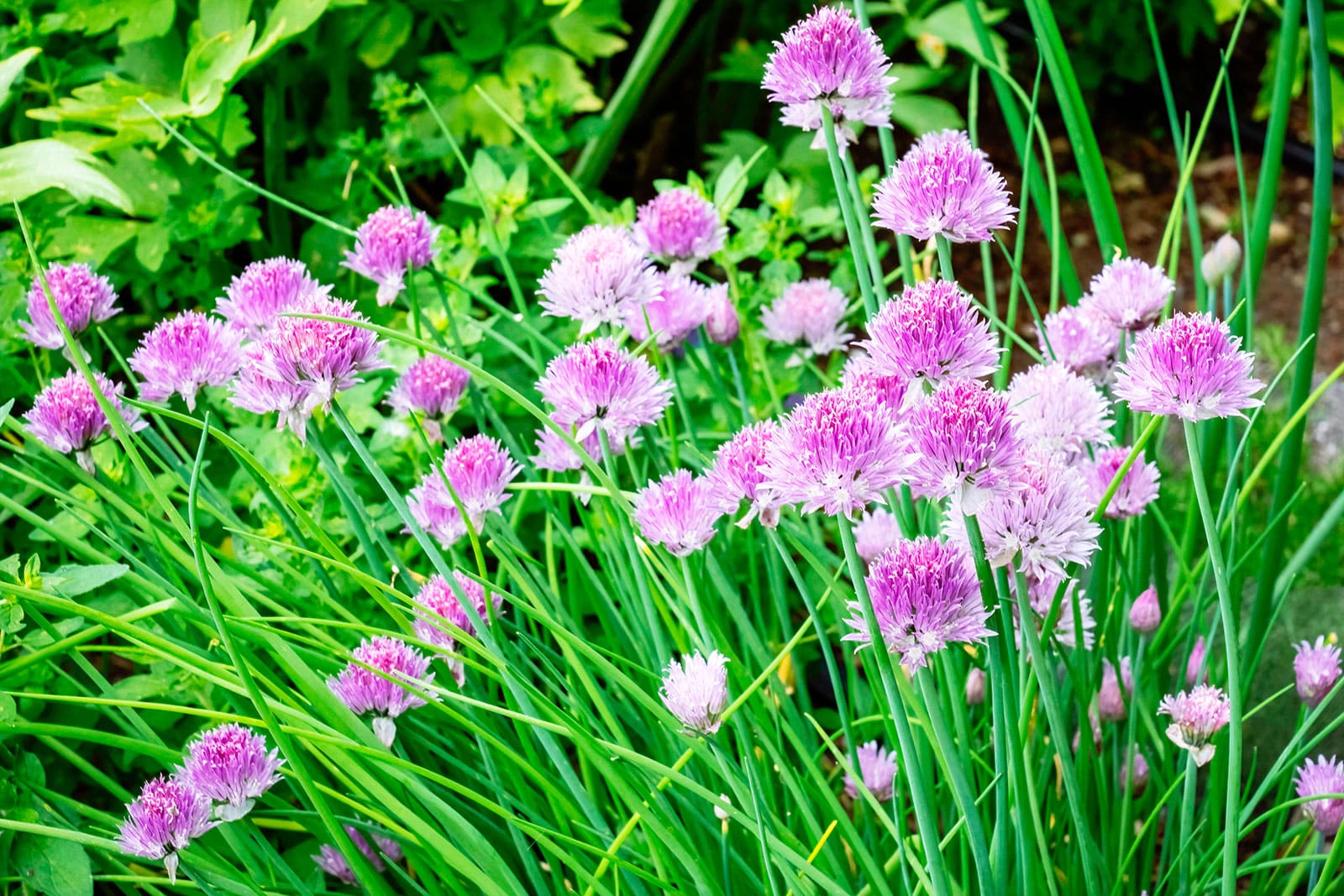
Good ol’ chives are the perfect choice if you’re looking for a hardy perennial herb, as they can survive as far north as Zone 3 by going dormant in the cold winter months.
Native to parts of North America, Europe, and Asia, this herb is a member of the genus Allium, meaning it’s closely related to onions, garlic, leek, scallions, and similar edible plants.
Chives, which kind of resemble clumps of thick grass, are pretty vigorous growers. They like full sun, although I’ve found them to do absolutely fine in partial shade as well. They like rich and lightly moist soil, although it’s important to still make sure there’s plenty of drainage.
Read more: 60+ Best Vegetables, Herbs, and Fruits That Grow in Shade
I’m sure you’ve used chives before, like in mashed potatoes, salads, or a nice omelette. But did you know that you can use more than just the leaves? Pretty purple chive flowers are also edible, making a beautiful addition to things like herb butter. You can even pickle them!
Garlic chives (Allium tuberosum)

Yep, there’s more than one type of chives. Whereas the aforementioned “regular” chives are quite delicate and only lightly oniony, garlic chives—as the name suggests—are strongly garlicky. They’re naturally found in northern China, making them hardy between Zones 3 to 9 in the US.
Garlic chives are popular in Chinese and Japanese cooking, such as in stir fries and to flavor dumpling fillings. Because the white flowers are quite pretty, these are sometimes used in bouquets as well (they don’t smell like garlic, luckily).
Grow garlic chives in medium shade to full sun, similar to regular chives. They like rich but well-draining soil. Keep lightly moist and harvest frequently to encourage strong, healthy growth.
Tarragon (Artemisia dracunculus)

Popular in traditional French cooking but not all that common outside of it, tarragon is one of those herbs that I think more people should give a try. Its mild flavor is somewhat reminiscent of anise, but sweeter and fresher.
Tarragon is naturally found throughout much of Europe, Asia, and North America. As such, you should be able to grow it in your herb garden without too much trouble as well. This perennial herb is hardy to Zone 4, going dormant in winter but emerging for another round of growth at the start of spring.
Tarragon’s main claim to fame is that it’s one of the four classic French ‘fines herbes’, along with chives, chervil, and parsley. I love it used in herb butter and sprinkled onto cheeses, though it also works very well in salads and fish dishes.
African blue basil (Ocimum kilimandscharicum × basilicum ‘Dark Opal’)

Here’s something you may not have known: Basil is a short-lived perennial plant in its native African and Mediterranean habitats!
While it’s challenging to keep popular varieties like sweet basil and Genovese basil alive for more than a growing season (even in a warm climate), I’ve found that hybrids are often hardier and live longer.
My favorite is African blue basil, a hybrid resulting from a cross of two other basil varieties. I had the same plants in my Southern California garden for seven years, and they probably continued to thrive, even after I moved away.
Since 2010, I’ve been growing African blue basil in the ground and in pots, and I’ve also propagated hundreds of basil babies from the original mother plant and gifted many seedlings to friends.
Not only is this a very pretty, bushy herb (with purple-flecked leaves and elongated flower spikes full of tiny blooms), it’s insanely attractive to pollinators. Every spring and summer, dozens of bees flit around my African blue basil all day long!
Unlike other basil cultivars, you can actually leave the flowers on this one. African blue basil is sterile and won’t go to seed, so its flavor won’t be ruined when it bolts.
You can grow African blue basil outdoors as a perennial in Zone 10 or higher. Use the leaves in sauces or dips, and sprinkle the edible flowers on salads.
Lovage (Levisticum officinale)
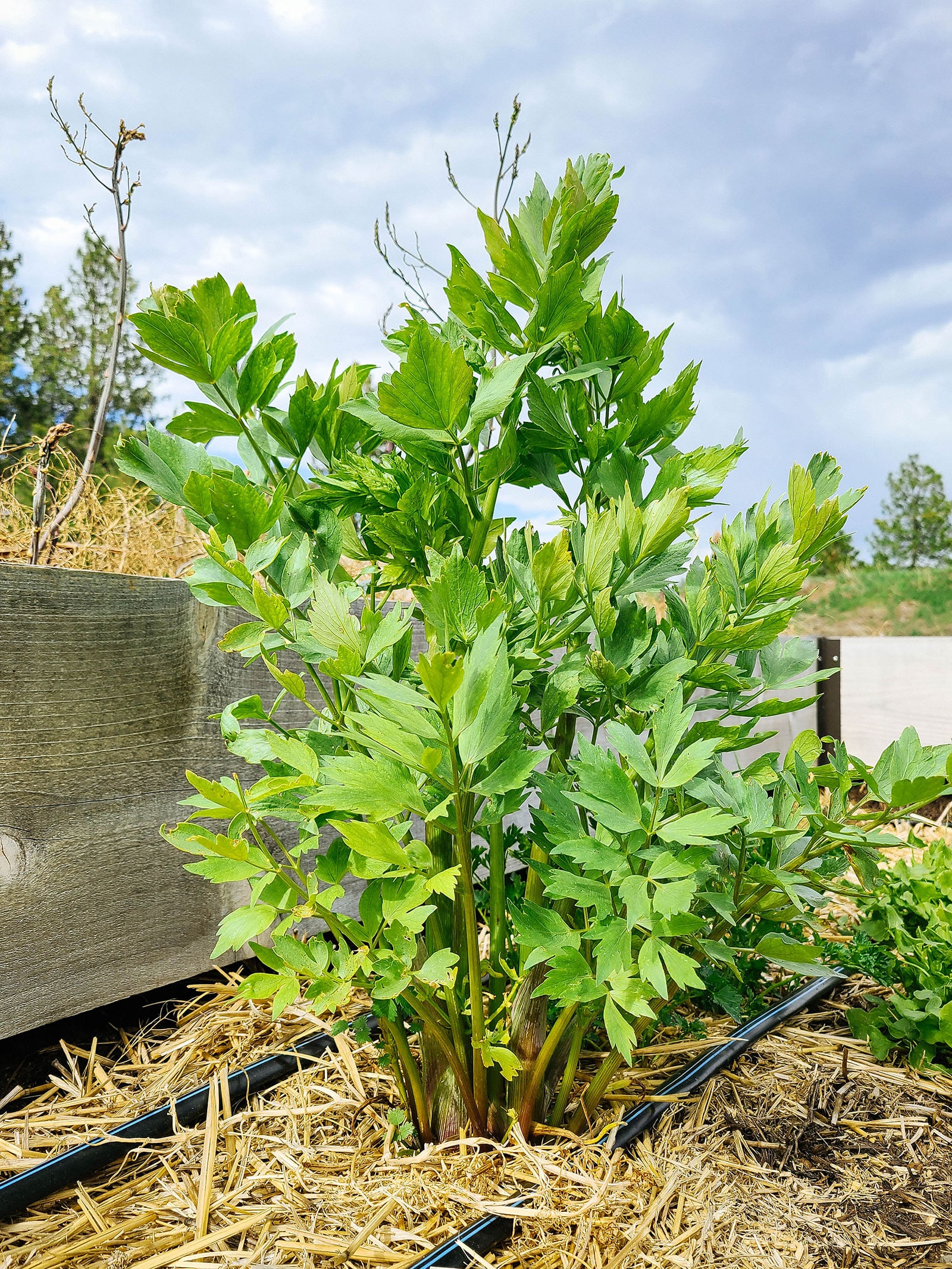
If you think the leaves of lovage look suspiciously like those of a celery plant, you aren’t wrong. The two are actually members of the same family of plants, and their flavor is considered to be similar, although lovage is definitely the more pungent of the two.
This herb is not a huge fan of hot weather, so it’s a great choice for Zones 4 to 8. Grow yours in full sun to partial shade. The soil should be lightly moist and nice and rich, so be sure to add some extra compost.
Lovage root can be eaten, and is sometimes used in herbal teas in its dried form. The plant is usually grown for its leaves, though; they work well in soups, stocks, and salads. You can also use the seeds in bread or as a spice.
Remember, lovage is very strong, so a little goes a long way!
Bay laurel (Laurus nobilis)

Here’s an herb that actually grows on trees! Native to the Mediterranean like many of the other plants on this list, bay laurel (also known as the bay tree or just laurel) is known for its aromatic foliage. The leaves are considered crucial in many pasta sauces and help to enrich soups and stews with their soft minty-eucalyptus flavor.
Bay laurel is hardy down to Zone 8, although you can keep yours in a pot and just bring it indoors during the winter months if you live in a colder climate. It likes lots of sun and well-draining soil.
If you’d like to use bay laurel in your cooking, you can pick the leaves and use them fresh or dried. Be sure to remove the leaves before serving, as they don’t taste very pleasant when you bite into them.
Curry leaf plant (Murraya koenigii)

Native to India and Sri Lanka, curry leaf plants like it hot—they grow in Zone 10 and up, but make beautiful container plants and houseplants with their dense, fragrant leaves and open growth pattern.
Curry leaves can be used fresh or dried in much the same way as bay leaves: to season soups, stews, and rice dishes.
While curry leaf plants can grow to be trees in the tropics (and in hot and humid places like Florida and Texas), you’ll generally have the most success growing curry leaf as a small shrub. You can also look for dwarf varieties that keep well as potted plants for overwintering indoors.
Once temperatures are consistently above 50°F, move the plant outside and give it plenty of sun.
I should add that curry leaf plants should not be confused with Helichrysum italicum, another perennial flowering plant that’s commonly known as a curry plant (due to the strong smell of its leaves). You can easily tell them apart as Helichrysum italicum resembles lavender.
Fennel (Foeniculum vulgare)

When I used to live in California, I came across fennel growing wild all over the place. It was pretty much considered a weed!
See more: Other common weeds that you can eat
That was good news for me, as this aromatic perennial herb has a lot of different uses. Seriously: You can eat the seeds (including the fresh green seeds), the bulb (though not in wild fennel), the stalks, leaves, and even fennel pollen.
As an added bonus, fennel is one of those herbs that basically grows itself. All you have to do is plant it; it’ll handle the rest.
In fact, you should be careful not to let the seeds spread too much, or you may end up with fennel all over the place! The plant is hardy down to Zone 4 and growing a patch of fennel will attract swallowtail butterflies to your garden.
The parts of the fennel plant used as herbs are the leaves and pollen. The former are delicious in sauces served with fish or in salads, while the latter is great in creamy soups or sprinkled over shellfish.
Salad burnet (Sanguisorba minor)

Salad burnet may not look like much—just a tangle of leaves with some unassuming reddish flower spikes sticking out in all directions—but it’s actually a wonderful addition to your perennial herb garden. Native to much of Europe, Africa and Asia, it’s quite hardy and tastes delightfully like cucumber.
You can grow salad burnet outdoors year-round in Zones 4 to 8, though you may be able to go higher as well if you place it in a sheltered spot. Full sun to half shade works well. Poor soil is no problem for this plant, although it does appreciate being kept lightly moist.
As its common name suggests, salad burnet makes a great addition to salads. You could also use the leaves in herb butter or for a refreshing summer cocktail. You can learn more about growing this herb and its uses in my full post on salad burnet!
Mitsuba (Cryptotaenia japonica)
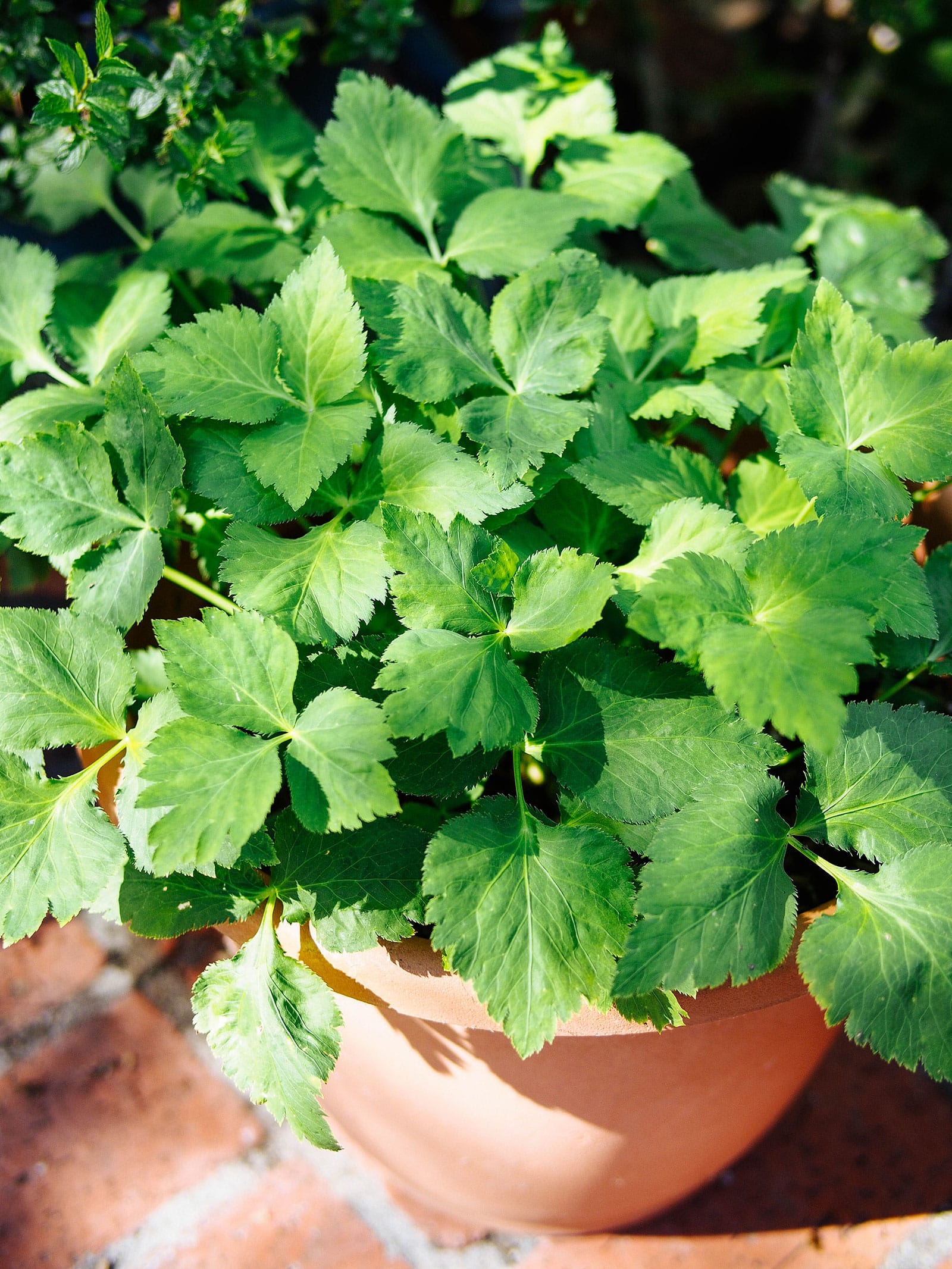
This trefoil (three-lobed) leafy herb looks a lot like flat-leaf parsley and even shares a similar “green” flavor to the parsley you’re familiar with.
But while mitsuba is often referred to as Japanese parsley, it’s a distinct herb used in Japanese and Chinese cooking with a flavor that I can only describe as being a cross between parsley and celery (and maybe a hint of cilantro).
In the wild, the plant can reach heights of 3 feet or more but in my experience, mitsuba typically grows 1 to 2 feet high in a home garden. The stems and leaves stay tender at maturity and if you pinch them back (the same way you might harvest basil), mitsuba will grow bushier and stay more compact.
I’s available in both green and purple varieties, but I haven’t found them to taste any different. The plant likes moist, rich soil and a bit of shade in summer, so I interplant it with taller herbs to keep the foliage lush and healthy.
Mitsuba is perennial in Zones 5 to 9, though it can come back in Zone 4 with some winter protection, and it will absolutely thrive in Zone 10 (where I first grew it) if given dappled or partial shade for most of the day.
Common sorrel (Rumex acetosa)

Another totally unassuming herb that packs surprising levels of flavor is sorrel. Native to Europe and Asia, it has been cultivated in these regions as a leafy green and herb for a very long time. The young leaves are tender and sharply tangy and lemony.
You can grow sorrel as a perennial in Zones 5 to 9, and I’ve found that it’s usually one of the first plants to come back up in early spring.
Luckily for lazy gardeners, sorrel really isn’t fussy; it does well in sun or half shade and is not too demanding when it comes to soil and watering. Just make sure the soil is nice and rich, and keep it lightly moist for the best results.
Sorrel is used in traditional dishes in several countries. The leaves are a particularly popular addition to soups, lending a fresh note to recipes like my creamy leek and sorrel soup. They also work well in salads, and you can even add them to stir-fries!
Red-veined sorrel (Rumex sanguineus)

Members of the genus Rumex (including the aforementioned common sorrel) are known as docks. That explains why red-veined sorrel, with its dramatic leaf coloring, is also sometimes referred to as bloody dock!
Red-veined sorrel can be found in Europe, where it grows in wooded areas.
In your herb garden, it’s hardy to Zones 4 to 8 and prefers half shade to full sun and rich, damp soil. You can learn more about growing this plant and using it in my full post on red-veined sorrel.
Because red-veined sorrel contains higher levels of calcium oxalate crystals than common sorrel, it tastes almost like a super tangy spinach. This mean it’s not a good idea to eat it by the bushel, as that would give you a stomach ache, but there’s no reason not to mix some bloody dock leaves into a salad or use them to perk up a vegetable soup.
True French sorrel (Rumex scutatus)

Okay, one more sorrel. I’m just obsessed with that burst of tangy flavor they add to soups and salads! It’s almost like lemon zest, tart and fragrant at the same time. True French sorrel can be told apart from the aforementioned species by its more delicate, arrowhead-shaped foliage.
This sorrel can be found in Europe, although its natural range also stretches into the Middle East.
In the garden, it’s hardy down to Zone 5. Like its cousins, it can grow in full sun or half shade, and it likes rich soil that’s kept lightly moist. Find out more in my full post on true French sorrel!
Good-King-Henry (Blitum bonus-henricus)

Ever heard of poor man’s asparagus? Often viewed as a weed in the regions where it naturally grows (central to southern Europe), Blitum bonus-henricus, good-king-henry, or Good King Henry (as it’s sometimes spelled) actually has a long history of being grown for use as a vegetable or herb. Let’s bring it back!
Good-king-henry can be recognized by its arrowhead-shaped leaves and yellow to orange-ish flower spikes.
It can be grown as a perennial in Zones 3 or up, making it pretty darn hardy, and is truly unfussy. Place it in any location or soil type, making sure it gets plenty of water.
As the asparagus thing I mentioned earlier suggests, the young shoots of this plant can be eaten in a similar manner. The leaves can also be used and are often considered a spinach substitute (used fresh in salads), as their taste and texture are comparable.
Sweet cicely (Myrrhis odorata)

Like good-king-henry, sweet cicely originates from central to southern Europe. It’s related to plants like fennel and anise, and it does resemble these species, sporting feathered leaves and umbrella-like white flower heads (referred to as umbels).
Another nice and hardy perennial herb, sweet cicely will do well from Zone 3 to about Zone 7. It’s not much of a sun lover, preferring a shaded location where it won’t get scorched and the soil stays moist for longer.
If you like anise flavor, you can substitute sweet cicely. Use the leaves in salads, soups, stews, and more. It’s quite sweet, making it perfect for things like syrup or even jams and jellies. The seeds can go in bread and baked goods.
Roman chamomile (Chamaemelum nobile)

I don’t know about you, but I love everything chamomile. It’s such a sweet dainty flower with a light warm fragrance, not to mention all of its medicinal benefits. And did you know that you can actually grow this powerhouse herb in your garden?
Don’t mistake Roman chamomile for its cousin, German chamomile—the latter is an annual, even though it self-seeds so readily that it may seem like it’s growing back from its roots!
You can grow Roman chamomile outdoors year-round in Zones 4 through 9; just give it full sun or partial shade and sandy, well-drained soil.
Roman chamomile blooms in early summer and has a pleasant apple scent. You can use the flowers to make herbal tea (or iced tea in summer), but don’t pass up on trying it in jams, syrups, cocktails, and even homemade cosmetics either. Or mix it with some bourbon for an excellent homemade natural cough syrup!
Echinacea (Echinacea sp.)

You may have heard of Echinacea (also called coneflowers) being irresistible to bees and other pollinators, which is a great reason to grow them in your garden. But did you know they also have other uses?
Although Echinacea has unfortunately been debunked as a remedy for the common cold (recent studies show that the herb has little effect on symptoms), at least it still makes an excellent herbal tea!
You can grow Echinacea as a perennial herb in Zones 3 to 9. Plant them pretty much anywhere, since these low-maintenance plants won’t ask a lot of you. (Although I do recommend full sun and well-draining soil for best results.) Once established, they’re fairly drought-resistant.
Aside from tea, you can use Echinacea flower petals to spruce up salads and drinks. It also makes a great addition to homemade cosmetics like salves and lip balms.
















Hello! I simply would choose to make a huge thumbs up for that excellent info you may have here for this post. We are coming back to your blog site to get more detailed soon.
Thank you!
THANS FOR THE INFORMATION!!!!! I LOVE HERBS AND APPRECIATE YOUR INFORMATION, PLEASE !!!!!! CAN YOU TELL US ABOUT GROWING HERBS IN FLORIDA USA NORTH , CENTRAL , AND SOUTH FLORIDA , FLORIDA ITS A TROPICAL STATE MOST IN CENTRAL AND SOUTH FLORIDACI HAVE TRIED A LOTS OF HERBS AND BELEAVE ME , ITS HARD TO GROW HERBS HERE , MAYBE IM DOING SOMETHING DIFFERENT AND WHRONG.
Thanks for all this information. Some of these I haven’t heard of and I live in zone 7. I can’t wait to go looking for all of these.
It is a grape leaf, and it is a real miracle, and in Iran we make a traditional dish called dolmeh with it.
Thanks a lot for information and list
But I want to introduce a plant that is a pharmacy by itself, and you don’t need any of the vitamin pills and nutritional supplements anymore.
StrictlyMedicinal.com is another great site for herb seeds.
This is quite a handy list! Lots of good ideas. However, it would be more helpful if you identified plants that are invasive. Plants in the mint family can be a nightmare to remove after they escape their pots! Lemon balm is another plant best given as a gift to someone you secretly hate. Sweet Cicely is on that list too.
The suggestion of the sterile basil is absolutely wonderful. Though I wouldn’t mind having more basil around, the flowers on other varieties reduce leaf production.
Shit i let out 7 lemon balms in my garden this year
It’s also wonderful in chicken salad & I always use it in chicken soup!!!! It’s such a delightful flavor and gives these dishes just a little something extra.
Thank you for the list and information. Wonderful to read all about these herbs. Can you tell me where you get the curry leaf plants from.
Thank you.
If you can’t find it in a local nursery, Etsy will probably be your best bet, like this shop: https://rstyle.me/+l5jBoWcPFSDK_9di0JtNKw
Hi
You can find it in India
Mohsen iran
This is a fantastic list! What I would love to see is a follow up on what these herbs need done to them, if anything, to prepare for over winter. Should they get cut back? Covered up/protected in some way? Or just brought inside?
I don’t cut back my perennials until spring when I start seeing new growth. Leaving the dead foliage helps protect the soil and roots over winter. As for whether you need to cover them or not (or bring them inside), it really depends on your zone. Plants that are hardy to your zone just need a thick layer of mulch over winter. If the plant is borderline your zone, then covering with frost cloth will help ensure it comes back.
This post is so helpful. I’m so glad you included growing conditions, zones, and how to use the herb. I want to add herbs I’ve never grown before and it’s a pain to look up each individually trying to track down use plus growing info. Thank you!!!
And tarragon is yummy in biscuits!
I’m glad you found this helpful! Hope you get to add some new herbs to your collection!